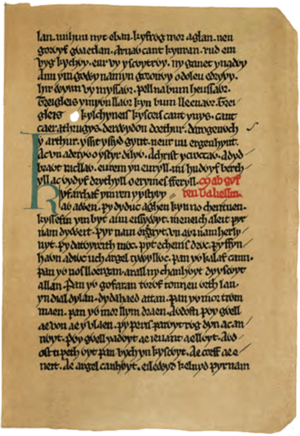Armes Prydein facts for kids
Armes Prydein (pronounced AR-mes PRUH-dine), which means The Prophecy of Britain, is an old Welsh poem from the early 900s. It's found in a famous book called the Book of Taliesin.
Contents
What is Armes Prydein About?
This poem is written in an exciting, heroic style, much like other old Welsh poems. It describes a future where all the Brythonic people (like the Welsh) team up with the Scots, the Irish, and the Vikings from Dublin. They would all be led by the Welsh. Together, they would drive the Anglo-Saxons (who were the English at the time) out of Britain forever.
The poem mentions two famous leaders from the past:
- Conan, who is said to have founded Brittany (a region in France).
- Cadwaladr, a king of Gwynedd (a kingdom in Wales) from the 600s.
Why Was This Poem Written?
Many people believe Armes Prydein was written because the Welsh were frustrated. At the time, their king, Hywel Dda, had a peaceful approach towards the powerful Kingdom of Wessex (an English kingdom).
The Rise of Wessex
Edward the Elder was the King of Wessex from 899 to 924. He became very powerful and was recognized as the leader over most people south of Scotland. This included the Gaels, Vikings, English, Cornish, Welsh, and Cumbrians.
After Edward died, his son Æthelstan became king (924–939). An alliance formed against him. This alliance included the kingdoms of Dublin, Scotland, and Strathclyde. They fought against Æthelstan at the Battle of Brunanburh in 937.
Welsh Choices
Historically, the Welsh had often sided with the "Men of the North" (called Gwŷr y Gogledd in Welsh) against the English. However, during the Battle of Brunanburh, King Hywel Dda and the Welsh did not join the fight. They didn't help their traditional allies (like the people of Strathclyde), nor did they fight their traditional enemies (the Saxons of Wessex). This decision likely made many Welsh people feel disappointed, leading to the strong feelings expressed in Armes Prydein.
When Was Armes Prydein Written?
A scholar named Andrew Breeze believes the poem was written in the summer or autumn of 940. He has a few reasons for this:
- The poem mentions "Lego," which he thinks refers to Leicester. In 940, King Edmund I of England had to make a humiliating agreement at Leicester. He surrendered parts of the midlands to a Viking leader named Olaf Guthfrithson.
- The poem talks about a victory happening after 404 years. According to old Welsh records (the Annales Cambriæ), the legendary King Arthur was killed in the Battle of Camlann in 537. If you add 404 years to 537, you get 941.
- Based on these points, Andrew Breeze suggests the poem was looking forward to the Anglo-Saxons being completely defeated in 941.


